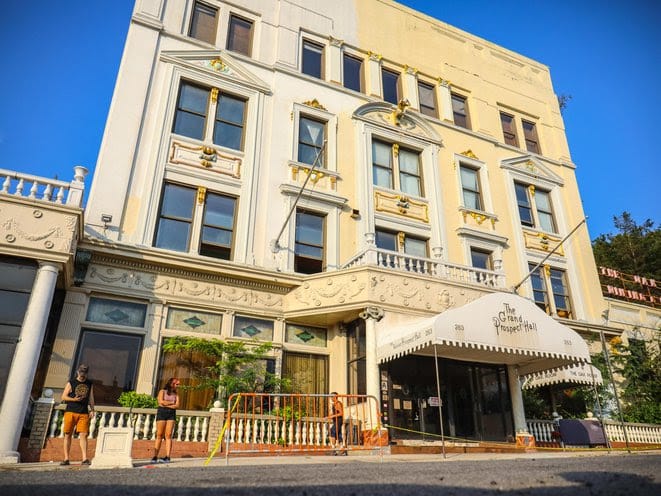Neighbors—and de Blasio—Rally to Preserve What’s Left of Park Slope’s Grand Prospect Hall
The outcry over plans to demolish the beloved Grand Prospect Hall in Park Slope continued Monday morning, as protestors gathered outside the shuttered event space to demand the city take action and Mayor Bill de Blasio voiced support for their cause.

The Grand Prospect Hall in Park Slope. (Image: Jim Glaser)
The outcry over plans to demolish the beloved Grand Prospect Hall in Park Slope continued Monday morning, as protestors gathered outside the shuttered event space to demand the city take action and Mayor Bill de Blasio voiced support for their cause.
About two dozen people stood outside the building chanting “save Prospect Hall” and holding signs with slogans like “landmark now!”
The rally comes days after Gothamist published photos showing that the interior of the banquet hall, which dates back to the late 19th century and became famous in part for its gloriously campy commercials, has been mostly demolished.
Still, activists are working to save the building’s facade. A petition calling on the city to step in to stop the demolition has garnered nearly 8,500 signatures, and a group of local activists led by Park Slope residents Jim Glaser and Solya Spiegel have submitted a request for evaluation to the Landmarks Preservation Commission (LPC), which could consider landmarking the building exterior, thereby saving it from the wrecking ball.
Local legislators, including City Council Member Brad Lander and State Assemblymember Robert Carroll, have also written to the Commission.
“Landmarking this beloved, historic building will help preserve a site that many in our communities have held dear for over a century,” the two wrote.
And on Monday, de Blasio jumped into the fray.
“I think that's a great question whether the facade could be saved,” he said at a press event Monday morning. “I certainly would love to see that happen. I'm going to see what the City can do to make that happen. I remember going there for so many community events and it was a place people cherished.”
An LPC spokesperson told Bklyner only that the request is currently under review.
Electrical contractor Angelo Rigas, purchased the property earlier this from longtime owner Alice Halkias, who ran the venue for over four decades with her husband Michael until he passed away last year due to complications stemming from COVID-19.
In late July, the city’s Department of Buildings (DOB) granted Rigas a demolition permit for interior non-structural elements of the building. An additional application for full demolition of the building was filed July 23rd, but the DOB said it has not yet received the necessary filings from Rigas to issue the permit.
The owners also have an active DOB permit for the sidewalk shed in front of the building, an agency spokesperson said.
Rigas did not immediately respond to a request for comment from Bklyner, but his spokesperson Bill Farrell, told Gothamist that the historic interior fixtures had already been removed by the time they took over the property.
“We very much appreciate the community’s attachment to the Grand Prospect Hall," Farrell told the news site. "After the previous owner was unable to find a buyer for the business, it proved infeasible for it to remain a catering hall and they opted to sell the property outright. The interior fixtures had been removed before current ownership took possession of the site, which is planned to be a low-scale residential building with an affordable component."
A partial stop work order has been issued to protect a Polish American war memorial located on the eastern side of the lot, which had been behind a fence and inaccessible to the public. Farrell told Gothamist it was working with the Polish consulate general in New York to relocate the memorial.
That stop work order does not prevent the owners from moving forward with the permitted interior demolition work.
The building was first constructed in 1892 by a local entrepreneur who envisioned it as a “temple of music and amusement,” according to Grand Prospect Hall’s website. It was redesigned after a fire in 1900, when the marble and granite lobby, oak and mahogany paneling, and giant crystal chandeliers were added. The building was home to many Brooklyn superlatives: it had the borough’s first “French birdcage” elevator, its highest roof garden, and was its first electrified commercial building, the website says.
The building was entered into the National Register of Historic Places in 1999, but that designation does not offer protection from demolition or alteration.




